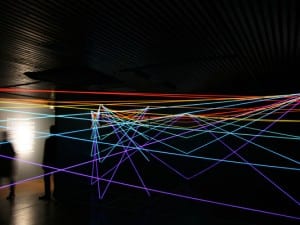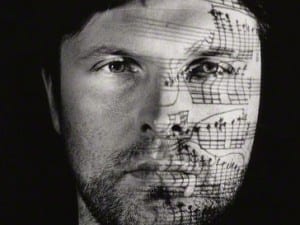Grand Union is an artist run project space in the metallic confides of Digbeth, Birmingham. The current exhibition, The Possibility of an Island, focuses on the question of what an ‘island’ is, and how said ‘island’ interacts with its environment through video, sculpture and drawing. It conjures up, even before entering the space, a unique physical tension. As the title appears to be negotiating the possibility of an island existing, one is immediately deemed to analyse what an island is. An island is something that is removed from a larger body of land, thus it tends to mould and warp the influence it has gained from other landmasses to its own isolated fixation. In doing so is it saying that this is what the work is going to be – a collection of art works crushed together in grotesque and distorted manner thick with conflict and invasiveness?
Unsure as to whether or not it is part of the exhibition, Thomas Chaffe’s The Largest Possible Plinth To Enter The Space Without Altering The Fabric Of The Building (2008/12) a large rectangular plinth stands tall in the doorway blocking any other visible sign of the exhibition. Its matt white finish mirrors the interior of the gallery perfectly allowing it to so simply remain unobtrusive to its minimal cosmetic surrounding aesthetic. Despite its obvious association to an island – it sits alone encompassed by the expansive cold grey floor, it has more in common with an island of warring primitive cavemen. Behind and to its right Sean Edwards’ Shelf I, II, III, IV (2011) a series of MDF sculptures drift in its wake. These sculptures, bare and resembling an assemblage of driftwood and dotted sparsely with what could be seen as small trinkets – perhaps playing on the scenario of a ship wreck or great tempest. The frames are mere shells of the shape cast off by the plinth. However when investigating the relationship between these works the fact that the plinth is the unique isolated piece gives it a supreme sense of physical dominance, the impenetrable machine-like autonomy gives a delayed presence of empathy and humanity to the series of shelves and their creator.
One of the most sublime relationships between creations is seen in Stuart Croft’s Film Drive In (2007) and Cory Arcangel’s appropriated video Sans Simon (2004). Drive In is set aside inside a blackened booth and is a paradoxically seductive take on the American road film genre. The film shows a man and a woman driving endlessly through an unnamed run of the mill American city during a rain stricken night – the windows are blurred by the rain crashing into the which further denies the opportunity of finding details of where they could be. While the woman speaks a lonesome piano accompanies her. This fused together with sound of the torrential rain and the unforeseeable moments of contemplative silence add an atmosphere of intensity and isolation between these two. The woman is recanting, crudely, a joke where upon becoming washed up on a beach the main protagonist character of the man, whose former life, steady and unexcitable, culminates in divorce, estrangement and being unemployed leaving no option but to run away. On this tropical paradise he finds the woman of his dreams living solely. She allows him to live with her and, over time, she begins to fall in love with him. As time grows old he grows bored and decides to leave in search of more hidden treasures. He goes to the other side of the island and in a bay sees a huge building and the girl of his dreams… the punch line has been removed allowing for the story to become a never ending cycle of discovery. The mental image of the tropical landscape is carved ceremoniously through the harsh damp gloom of the overbearing city outside the car. The woman is extremely confident and slightly aggressive with her assertiveness towards the man driving. His face is timid and he remains tragically silent.
When looking from the booth one is able to capture at the same time the silenced flickering of Sans Simon. Displayed on a monitor one must use head phones to listen to a recording of a Simon and Garfunkel concert where, Cory, upon seeing Simon on the screen covers him up with his hands. The again, obvious relation to an island where a duo has been dissected in to one seems somewhat irrelevant when witnessed in conjunction with Drive In. Both are seem completely un-relatable in subject matter and visual aesthetics. However both require an act of seclusion for the viewer to successfully absorb there worth. Drive In requires a degree of removal from the space like a cinema; it plays upon ones sense of sound and perception. San Simon requires a mental focus and abuses the sense of touch to keep one in place. The headphones offer the only admittance of sound. Therefore the feel of the headphones is what is going to deliver the relationship between this ‘island’ of creation and the viewer.
The necessity for becoming introspective of the title and the subject of the pieces is wonderfully coordinated. But it’s not until long after one finds that the possibility of an island within the gallery is nothing more than a condensed scenario in which life is mirrored.
The Possibility of an Island, 14th July until 18th August, Grand Union, 19 Minerva Works, Fazeley Street, Birmingham , B5 5RS. www.grand-union.org.uk
Text: William Davie
Credit:
Sean Edwards, Shelf I, II, III and IV and Tomas Chaffe Approx. 1217 x 1954 x 2930mm (The Largest Possible Plinth to Enter the Gallery Space Without Altering the Fabric of the Building)
Image courtesy Grand Union, the artists and Limoncello





